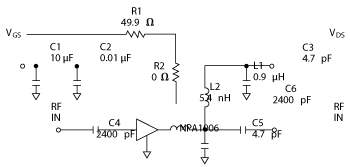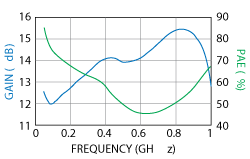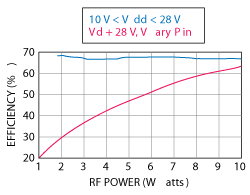
Figure 1 Matching network for the NPA1006 provides a broadband match to 50 Ω.
Despite radio standard evolution, interoperability with older or other modulation formats/services remains a requirement, and the incorporation of these bands and standards into a single radio system poses a difficult design challenge. The simplest solution is to integrate multiple single band radios, but this can be impractical. A better solution is a single broadband radio, one capable of multiple bands and waveforms; but this places difficult restrictions on the radio designer requiring multi-band, multi-mode operation without compromising cost, size, or efficiency – a significant challenge.
Because the RF power amplifier dominates overall radio power consumption, the amplifier is often the key to achieving the design goals. The advent of Gallium Nitride (GaN) technology opens a practical path to next generation, flexible, future-proof, and frequency agile architectures for handheld radios. Radios based on these design platforms are both cost effective and configurable for land mobile radio standards deployed worldwide today, while being adaptable for the standards of tomorrow.
Typical handheld radio PA design requirements include:
- Battery packs of 4.5 to 12 V, usually around 2 amp-hours
- Moderate output power, 1 to 10 W at the PA, 1 to 8 W at the antenna
- RF power control for battery conservation, -6 to -10 dB reduction typical
- ALC to maintain constant output power
- High PA efficiency to extend operating time, reduce battery size and weight
- 50 Ω load impedance but must tolerate moderate VSWR from broadband antennas
- Small area and volume, low cost

Figure 2 Gain and PAE vs. frequency for NPA1006.
The NPA1006 Handheld Solution
The NPA1006 is an integrated GaN power amplifier that offers 10 W minimum output power from a 28 V supply continuously from 20 MHz to 1 GHz. The package is a low profile overmolded plastic 6×5×1 mm surface mount (SMT) package well suited to the space limitations of a handheld product. External support circuitry is minimal, requiring only a few passive lumped elements on the output to improve the high frequency performance and provide proper depletion-mode GaN transistor biasing.
The NPA1006 includes internal input-matching providing a near 50 Ω input impedance. The output of the PA is unmatched, but a simple matching network provides a broadband match to 50 Ω, as seen in Figure 1. Combining high operating voltage and low intrinsic capacitance, the transistor works well natively from low to mid band for both large and small signal conditions. At high frequencies the simple external match of the applications circuit maintains good power and efficiency through 1 GHz. The external output match can also be optimized for narrower band performance if desired (such as VHF/UHF or UHF/800 MHz only).
Figure 2 shows broadband performance of the NPA1006 at 41 dBm (12.5 W) output power with power added efficiency (PAE) ranging from 50 to 85 percent. Figure 3 shows both gain and PAE versus output power.

Figure 3 Gain (a) and PAE (b) vs. output power for NPA1006.

Figure 4 Efficiency using power control by adjusting input drive only (red) and adjusting both the input drive and the supply voltage (blue).
Targeting peak efficiency will provide the longest battery life for a portable radio. Using a battery plus DC-DC converter configuration for the power supply of the radio allows real-time adjustment of the amplifier supply voltage up or down as needed. For every combination of frequency, desired output power, and load VSWR there is an optimum supply voltage for best efficiency. The efficiency difference between using power control by adjusting input drive only, and the proposed configuration, which adjusts both the input drive and the supply voltage, can be significant. Figure 4 contrasts these two approaches with the NPA1006 operating at 100 MHz.
By reducing both the drive and the supply voltage the efficiency remains well above 60 percent from under 2 W to more than 10 W as seen in the upper curve. Using drive reduction alone the lower red curve shows that the efficiency falls rapidly at low power levels. A variable supply voltage, intelligently controlled, can reduce or counter the effect of these factors while maintaining maximum performance. Thermally, the NPA1006 is an optimized device with a low 4.6° C/W thermal resistance.
The next generation of LMR radios must support both legacy and LTE modulation and frequency bands. While it is possible to continue to expand capability through stacked system blocks, the more efficient method takes advantage of software defined radio advances combined with broadband GaN based power amplifiers. These new systems provide ultimate flexibility supported by simple transceiver architectures.
MACOM,
Lowell, MA,
www.macom.com
